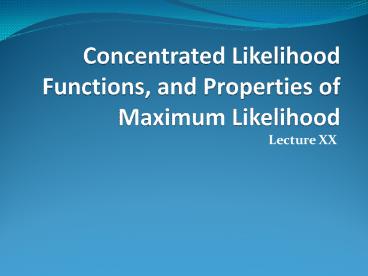Concentrated Likelihood Functions, and Properties of Maximum Likelihood PowerPoint PPT Presentation
Title: Concentrated Likelihood Functions, and Properties of Maximum Likelihood
1
Concentrated Likelihood Functions, and Properties
of Maximum Likelihood
- Lecture XX
2
Concentrated Likelihood Functions
- The more general form of the normal likelihood
function can be written as
3
- This expression can be solved for the optimal
choice of s2 by differentiating with respect to
s2
4
- Substituting this result into the original
logarithmic likelihood yields
5
- Intuitively, the maximum likelihood estimate of m
is that value that minimizes the mean square
error of the estimator. Thus, the least squares
estimate of the mean of a normal distribution is
the same as the maximum likelihood estimator
under the assumption that the sample is
independently and identically distributed.
6
The Normal Equations
- If we extend the above discussion to multiple
regression, we can derive the normal equations.
7
- Taking the derivative with respect to a0 yields
8
- Taking the derivative with respect to a1 yields
9
- Substituting for a0 yields
10
(No Transcript)
11
Properties of Maximum Likelihood Estimators
- Theorem 7.4.1 Let L(X1,X2,Xnq) be the
likelihood function and let q(X1,X2,Xn) be an
unbiased estimator of q. Then, under general
conditions, we have - The right-hand side is known as the Cramer-Rao
lower bound (CRLB).
12
- The consistency of maximum likelihood can be
shown by applying Khinchines Law of Large
Numbers to - which converges as long as
13
Asymptotic Normality
- Theorem 7.4.3 Let the likelihood function be
L(X1,X2,Xnq). Then, under general conditions,
the maximum likelihood estimator of q is
asymptotically distributed as
PowerShow.com is a leading presentation sharing website. It has millions of presentations already uploaded and available with 1,000s more being uploaded by its users every day. Whatever your area of interest, here you’ll be able to find and view presentations you’ll love and possibly download. And, best of all, it is completely free and easy to use.
You might even have a presentation you’d like to share with others. If so, just upload it to PowerShow.com. We’ll convert it to an HTML5 slideshow that includes all the media types you’ve already added: audio, video, music, pictures, animations and transition effects. Then you can share it with your target audience as well as PowerShow.com’s millions of monthly visitors. And, again, it’s all free.
About the Developers
PowerShow.com is brought to you by CrystalGraphics, the award-winning developer and market-leading publisher of rich-media enhancement products for presentations. Our product offerings include millions of PowerPoint templates, diagrams, animated 3D characters and more.

